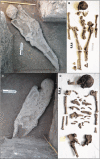Persistent Early to Middle Holocene tropical foraging in southwestern Amazonia
- PMID: 31032413
- PMCID: PMC6482008
- DOI: 10.1126/sciadv.aav5449
Persistent Early to Middle Holocene tropical foraging in southwestern Amazonia
Abstract
The Amazon witnessed the emergence of complex societies after 2500 years ago that altered tropical landscapes through intensive agriculture and managed aquatic systems. However, very little is known about the context and conditions that preceded these social and environmental transformations. Here, we demonstrate that forest islands in the Llanos de Moxos of southwestern Amazonia contain human burials and represent the earliest settlements in the region between 10,600 and 4000 years ago. These archaeological sites and their contents represent the earliest evidence of communities that experienced conditions conducive to engaging with food production such as environmental stability, resource disturbance, and increased territoriality in the Amazonian tropical lowlands.
Figures





Similar articles
-
Early to mid-Holocene human activity exerted gradual influences on Amazonian forest vegetation.Philos Trans R Soc Lond B Biol Sci. 2022 Apr 25;377(1849):20200498. doi: 10.1098/rstb.2020.0498. Epub 2022 Mar 7. Philos Trans R Soc Lond B Biol Sci. 2022. PMID: 35249380 Free PMC article.
-
Early Holocene crop cultivation and landscape modification in Amazonia.Nature. 2020 May;581(7807):190-193. doi: 10.1038/s41586-020-2162-7. Epub 2020 Apr 8. Nature. 2020. PMID: 32404996 Free PMC article.
-
Early and middle holocene hunter-gatherer occupations in western Amazonia: the hidden shell middens.PLoS One. 2013 Aug 28;8(8):e72746. doi: 10.1371/journal.pone.0072746. eCollection 2013. PLoS One. 2013. PMID: 24013964 Free PMC article.
-
The deep human prehistory of global tropical forests and its relevance for modern conservation.Nat Plants. 2017 Aug 3;3(8):17093. doi: 10.1038/nplants.2017.93. Nat Plants. 2017. PMID: 28770823 Review.
-
Reconsidering the lives of the earliest Puerto Ricans: Mortuary Archaeology and bioarchaeology of the Ortiz site.PLoS One. 2023 Apr 26;18(4):e0284291. doi: 10.1371/journal.pone.0284291. eCollection 2023. PLoS One. 2023. PMID: 37099496 Free PMC article. Review.
Cited by
-
A new hypothesis for the origin of Amazonian Dark Earths.Nat Commun. 2021 Jan 4;12(1):127. doi: 10.1038/s41467-020-20184-2. Nat Commun. 2021. PMID: 33397930 Free PMC article.
-
Late Holocene dietary and cultural variability on the Xingu River, Amazon Basin: A stable isotopic approach.PLoS One. 2022 Aug 3;17(8):e0271545. doi: 10.1371/journal.pone.0271545. eCollection 2022. PLoS One. 2022. PMID: 35921285 Free PMC article.
-
Zaraa Uul: An archaeological record of Pleistocene-Holocene palaeoecology in the Gobi Desert.PLoS One. 2021 Apr 8;16(4):e0249848. doi: 10.1371/journal.pone.0249848. eCollection 2021. PLoS One. 2021. PMID: 33831092 Free PMC article.
-
Legacies of Indigenous land use and cultural burning in the Bolivian Amazon rainforest ecotone.Philos Trans R Soc Lond B Biol Sci. 2022 Apr 25;377(1849):20200499. doi: 10.1098/rstb.2020.0499. Epub 2022 Mar 7. Philos Trans R Soc Lond B Biol Sci. 2022. PMID: 35249381 Free PMC article.
-
p3k14c, a synthetic global database of archaeological radiocarbon dates.Sci Data. 2022 Jan 27;9(1):27. doi: 10.1038/s41597-022-01118-7. Sci Data. 2022. PMID: 35087092 Free PMC article.
References
-
- Arroyo-Kalin M., Slash-burn-and-churn: Landscape history and crop cultivation in pre-Columbian Amazonia. Quat. Int. 249, 4–18 (2012).
-
- Heckenberger M. J., Russell J. C., Fausto C., Toney J. R., Schmidt M. J., Pereira E., Franchetto B., Kuikuro A., Pre-Columbian urbanism, anthropogenic landscapes, and the future of the Amazon. Science 321, 1214–1217 (2008). - PubMed
-
- Levis C., Costa F. R. C., Bongers F., Peña-Claros M., Clement C. R., Junqueira A. B., Neves E. G., Tamanaha E. K., Figueiredo F. O. G., Salomão R. P., Castilho C. V., Magnusson W. E., Phillips O. L., Guevara J. E., Sabatier D., Molino J. F., López D. C., Mendoza A. M., Pitman N. C. A., Duque A., Vargas P. N., Zartman C. E., Vasquez R., Andrade A., Camargo J. L., Feldpausch T. R., Laurance S. G. W., Laurance W. F., Killeen T. J., Nascimento H. E. M., Montero J. C., Mostacedo B., Amaral I. L., Guimarães Vieira I. C., Brienen R., Castellanos H., Terborgh J., Carim M. J. V., Guimarães J. R. S., Coelho L. S., Matos F. D. A., Wittmann F., Mogollón H. F., Damasco G., Dávila N., García-Villacorta R., Coronado E. N. H., Emilio T., Filho D. A. L., Schietti J., Souza P., Targhetta N., Comiskey J. A., Marimon B. S., Marimon B. H. Jr., Neill D., Alonso A., Arroyo L., Carvalho F. A., de Souza F. C., Dallmeier F., Pansonato M. P., Duivenvoorden J. F., Fine P. V. A., Stevenson P. R., Araujo-Murakami A., Aymard C. G. A., Baraloto C., do Amaral D. D., Engel J., Henkel T. W., Maas P., Petronelli P., Revilla J. D. C., Stropp J., Daly D., Gribel R., Paredes M. R., Silveira M., Thomas-Caesar R., Baker T. R., da Silva N. F., Ferreira L. V., Peres C. A., Silman M. R., Cerón C., Valverde F. C., di Fiore A., Jimenez E. M., Mora M. C. P., Toledo M., Barbosa E. M., Bonates L. C. M., Arboleda N. C., Farias E. S., Fuentes A., Guillaumet J. L., Jørgensen P. M., Malhi Y., de Andrade Miranda I. P., Phillips J. F., Prieto A., Rudas A., Ruschel A. R., Silva N., von Hildebrand P., Vos V. A., Zent E. L., Zent S., Cintra B. B. L., Nascimento M. T., Oliveira A. A., Ramirez-Angulo H., Ramos J. F., Rivas G., Schöngart J., Sierra R., Tirado M., van der Heijden G., Torre E. V., Wang O., Young K. R., Baider C., Cano A., Farfan-Rios W., Ferreira C., Hoffman B., Mendoza C., Mesones I., Torres-Lezama A., Medina M. N. U., van Andel T. R., Villarroel D., Zagt R., Alexiades M. N., Balslev H., Garcia-Cabrera K., Gonzales T., Hernandez L., Huamantupa-Chuquimaco I., Manzatto A. G., Milliken W., Cuenca W. P., Pansini S., Pauletto D., Arevalo F. R., Reis N. F. C., Sampaio A. F., Giraldo L. E. U., Sandoval E. H. V., Gamarra L. V., Vela C. I. A., ter Steege H., Persistent effects of pre-Columbian plant domestication on Amazonian forest composition. Science 355, 925–931 (2017). - PubMed
Publication types
MeSH terms
LinkOut - more resources
Full Text Sources

